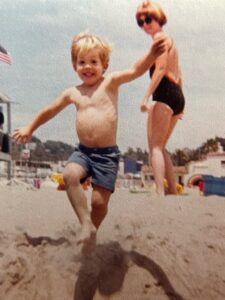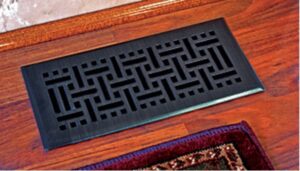Gratitude
 The videotape begins with a high-angle camera shot of a beefy middle-aged man securing a bike to the roof of a blue hatchback parked on the curb of a suburban street. He finishes up and walks around to the rear of the car. A teenage girl carrying a laundry basket stuffed with clothes and a tennis racket meets him there, slides the basket into the car, and closes its back door.
The videotape begins with a high-angle camera shot of a beefy middle-aged man securing a bike to the roof of a blue hatchback parked on the curb of a suburban street. He finishes up and walks around to the rear of the car. A teenage girl carrying a laundry basket stuffed with clothes and a tennis racket meets him there, slides the basket into the car, and closes its back door.
The camera shifts to eye-level as they face each other.
“Wow. College already,” he says.
“Yeah,” she says. They look at each other uncomfortably. “We gotta go,” she says.
She gets in the car. It pulls away, then stops abruptly. She jumps out, runs back to him, and hugs him. While they hold each other close, Celine Dion sings, “For all those times you stood by me/And all the truths you made me see.”
Because You Loved Me plays on as they separate, and the girl walks slowly back to the car.
He calls out anxiously, “And remember—”
She turns, grinning and counting to three on her fingers, “Seat belt, drive safe, call when I get there.”
They smile at each other, both fighting back tears.
“Well, bye,” he chokes out. “I love you.”
 She walks back to him, and they embrace again. “I love you too, daddy,” she says softly.
She walks back to him, and they embrace again. “I love you too, daddy,” she says softly.
They step back and look at each other for a long moment. She walks back to the car, hesitates, then faces him. “And thanks for … everything.” She climbs in the car. As it pulls away, she waves to him from the window.
Wiping tears away, he waves back.
I’ve seen that tape fifty times. I cry every time.
I relate to the beefy guy.

My son’s last night at home, we sat up watching television for an hour after Cindy and the girls went to bed. We didn’t say anything. We didn’t need words. We knew the next day he would take a big step through the portal passing from child to man. I wanted it for him, but I mourned the loss of my little boy.
I kept him up as late as I could without spoiling his next day, then took a deep breath, and stood. “Good night, Josh.”
“Love you, dad.”
“Love you, too, Josh,”
I lay awake half the night, remembering the good times.

The next morning, we drove him to Pepperdine. The campus sits on a mountainside above Malibu. His dormitory overlooked the baseball stadium, where he would play left field, and beyond that, the Pacific Ocean, glistening silver in the morning sunlight. We moved all his stuff into his room, stalled as long as we could, then hugged him, and left him sitting at his desk. When we walked across the courtyard, he called out from the window, “Bye, dad.”
My heart broke.
It mended, of course, as I watched him confront challenges, overcome setbacks, make life-long friends, and meet his future wife.
When the time came for our older daughter to leave the nest, I thought I’d get through it easier. It was my second rodeo, after all.
I was wrong.

When Devon was a little girl, we had friends over for dinner. We were talking in the living room when she climbed up in my lap. Cindy had dolled her up in a frilly dress and put little red bows in her silky blonde hair. I was primping her, mesmerized by her, as always, when our friend smiled and said, “Looks like someone has daddy wrapped around her little finger.”
And that was true.
The University of California at Santa Cruz was tailor-made for Devon and she loved it when she toured the campus, but when her last day at home finally arrived, she didn’t want to leave us. As we drove north toward the school, she cried.
I wracked my brain for some way to ease her pain about the separation. When we got there, she and I shared a quiet moment alone. I told her there was an invisible string that ran from my heart to hers, like an elastic spider web that would stretch across any distance. “It never breaks. It lasts forever, and our feelings for each other will always pulse through it.” I told her she had the same magical connection with Cindy, Chelsea, and Josh, and she would always be with us.

She said it was a beautiful thought, and it seemed to help her.
But when we left her there, my beautiful thought didn’t work as well for me as it did for her. I broke down in the UCSC parking lot and choked back tears all the way home.
That wound healed, too. UCSC was a caring, nurturing environment. Devon found her passion for art there and started down a path to a happy successful life.

I retired before the baby of the family graduated from high school. Spending more time at home, I watched all Chelsea’s swim meets and water polo matches. We worked out together. She couldn’t stop laughing when I collided with a stop sign on one of our long runs, and my excruciatingly painful, ill-conceived attempt to leap-frog a tall cement trash can provoked another hysterical fit.
When the time came to take her to college, I thought I was ready because I was a hardened veteran of two bruising treks down that rough road.
But I wasn’t ready.
Cindy and I kept our composure when we moved her into the University of Arizona, hugged her, and said goodbye, but later in the car, we cried.

To avoid the loneliness of our empty nest, we started traveling. Cindy and I had just checked into the Boar’s Head Inn in Charlottesville, Virginia, when the phone rang in our room. “Dad, this is Chelsea. The police are here. They read us our rights. They want our computers, but I won’t give them up. What do I do next?”
After Cindy picked me up off the floor, Chelsea filled me in on the details and I asked to speak to the officer in charge. “I don’t even know why I’m talking to you,” he said in an exasperated, somewhat intimidated voice. “Your daughter has nothing to do with this.”
The police thought Chelsea’s roommate was involved in a criminal conspiracy, but Chelsea didn’t believe it. She knew her roommate’s rights, and she was holding the police at bay. In the end, it turned out Chelsea was right. The police had made a tragic mistake, and her roommate was innocent.
From there on, I knew I didn’t have to worry about her. I was the proud father of a warrior-woman.
And the pain of my third and last heart-wound eased off.
Foundation for a Better Life, a non-profit for the promotion of good values, produced the tape about the beefy guy and his teenage daughter. At the end of it, after the girl thanks her dad, the narrator’s voice-over delivers the tape’s message, “Gratitude. Pass it on.”
 I appreciate the message, but I’d revise the script slightly to show that gratitude runs from the beefy guy to his little girl, too. I’d add these lines for him: “Thanks for all the good times, for your love, and for growing up to become someone I admire and respect. Thanks for … everything.”
I appreciate the message, but I’d revise the script slightly to show that gratitude runs from the beefy guy to his little girl, too. I’d add these lines for him: “Thanks for all the good times, for your love, and for growing up to become someone I admire and respect. Thanks for … everything.”
Post Script: The lyrics of Because You Loved Me run both ways, too:
For all those times you stood by me
And all the truths you made me see
For all the joy you brought to my life
For every dream you made come true
For all the love I found in you
You’re the one who saw me through it all.
You were my strength when I was weak
You were my voice when I couldn’t speak
Because you loved me.



 Cindy stood beside me clutching my arm as I flipped the deadbolt, opened the door, and pointed my shotgun at the chest of a black, angel-winged Led Zeppelin tee shirt worn by a stranger. In his mid-twenties, tall, and thin with shoulder-length blond hair and a hooked nose, he froze in the act of bringing a cigarette to his mouth and stared at the business end of my twelve gauge as though he couldn’t quite figure out what it was.
Cindy stood beside me clutching my arm as I flipped the deadbolt, opened the door, and pointed my shotgun at the chest of a black, angel-winged Led Zeppelin tee shirt worn by a stranger. In his mid-twenties, tall, and thin with shoulder-length blond hair and a hooked nose, he froze in the act of bringing a cigarette to his mouth and stared at the business end of my twelve gauge as though he couldn’t quite figure out what it was.



 I pulled on a pair of jeans. The single-shot twelve gauge I used for hunting in Virginia was propped in the corner of our bedroom closet. I grabbed it, retrieved a shell from our dresser drawer, and slipped it into the chamber.
I pulled on a pair of jeans. The single-shot twelve gauge I used for hunting in Virginia was propped in the corner of our bedroom closet. I grabbed it, retrieved a shell from our dresser drawer, and slipped it into the chamber. I kept the shotgun trained on him until he rounded the corner of the house. Cindy and I rushed out to the living room. From the front windows, we watched him walk out to the street, turn right at the sidewalk, pass under a streetlamp, and disappear into the night.
I kept the shotgun trained on him until he rounded the corner of the house. Cindy and I rushed out to the living room. From the front windows, we watched him walk out to the street, turn right at the sidewalk, pass under a streetlamp, and disappear into the night.

 Alarmed, I cast my light in that direction. A black snake lay coiled an arm’s length away, staring at me, its eyes glowing like little diamonds, its tongue flicking in and out.
Alarmed, I cast my light in that direction. A black snake lay coiled an arm’s length away, staring at me, its eyes glowing like little diamonds, its tongue flicking in and out.




